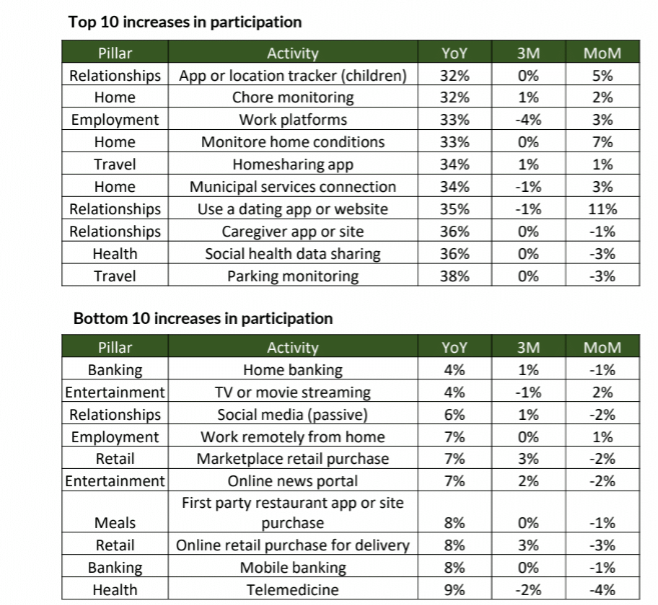
Consumers not physically employed in offices are spending in locations that are more convenient to them than the city.
One man’s meat is another’s poison goes the old saying, which it may be as applicable as ever when it comes to workers returning to the office and ensuing commercial real estate slump. As noted by The Wall Street Journal in May, average city office occupancy rates are still hovering at around half pre-pandemic rates, and some retailers are meeting consumers where they shop: closer to home.
This shift in where workers shop matches up with proprietary research carried out in preparation for the PYMNTS’ March ConnectedEconomy™ report, which notes the average year-over-year growth when it comes to selected digital activities.

The above chart notes both the astronomical rise in consumer participation in work platforms, such as Uber, rising 33% year-over-year, as well as the lesser performing but still growing working remotely from home at 7%. While these categories represent two different employment types, their commonality is that neither mode of employment are based within a physical office setting.
It may be little wonder, then, that the WSJ article notes the spread of formally city-focused franchises such as Sweetgreen closing several metro locations in favor of suburban spots. As well, DoorDash has been the first major aggregator to go after the so-far underserved suburban market. The company discussed its continued strength in these underpenetrated regions on its second-quarter 2022 earnings call last summer, after being asked whether it was facing any pressure from competitors in nonurban markets. “So far, we haven’t seen an impact [from] recent competitor announcements or moves to invest in certain types of geographies versus other types of geographies in the numbers,” said CEO Tony Xu at the time.
This shift in where workers work has undoubtedly had an economic impact on major cities such as New York, where remote workers are costing the metropolis a reported $12 billion annually. And the move may certainly spark a commercial real estate exodus finding offices falling to a fate similar to the classic shopping mall.
However, the move away from physical office workplaces may represent a benefit for businesses outside the real estate sector. In an interview with PYMNTS, Milan Parikh, CFO at workplace equity platform Syndio, explains why his company has embraced a remote office. “Fundamentally, I think it comes down to how do we keep people productive no matter where they are. One of the things that’s beneficial for me as the CFO is not having a huge facilities line, right? We don’t have this big overhead of an office and trying to manage it.”
While headlines are correct in that the workplace shift is a disaster for cities dependent on office real estate occupancies, it has resulted in the rise of other types of work and where those workers are shopping. In this current age where flexibility is key, sectors reliant on city office workers may need to adapt to survive.